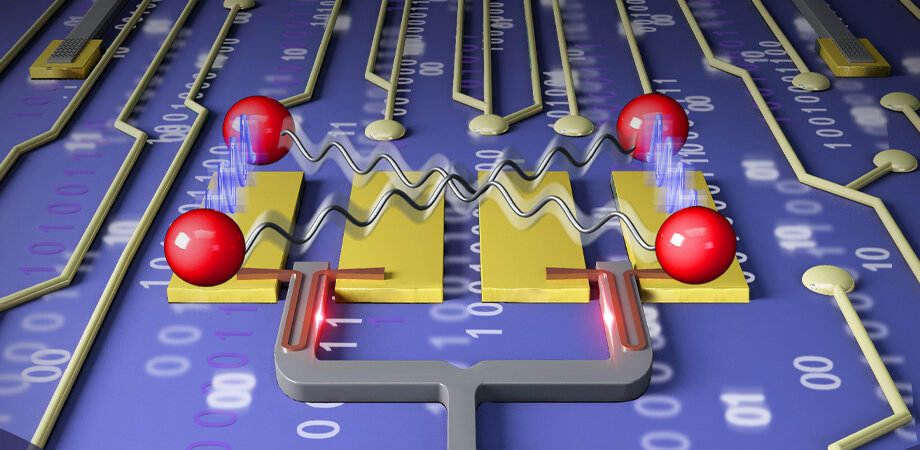
For secure quantum communication, a superconducting silicon chips is used as an untrusted server. The unique low-dead time feature of waveguide integrated single-photon detectors is harnessed (red wires with hairpin shapes in the middle), to achieve optimal time-bin encoded Bell state measurements (shown as blue and grey wave-like curves, indicated by red balls). These features enhance the security key rate for quantum communication. Credit: MaLab, Nanjing University
Integrated quantum photonics is a promising platform to realize practical and scalable quantum information processing. IQP has been used to demonstrate improvements in the quality, stability, and complexity of experiments on traditional platforms based upon bulk and fiber optical elements. The more difficult question is "Can IQP perform experiments that cannot be done with traditional technology?"
This question is answered by a team consisting of Xiao-Song Ma from Nanjing University and Labao Zhang, Sun Yat-sen University, China. The team uses a chip that is based on silicon photonics and a single-photon detector superconducting nanowire (SNSPD) to achieve quantum communication, as reported in Advanced Photonics. This chip's excellent performance allows them to achieve optimal time-bin Bell states measurement and significantly increase the key rate for quantum communication.
A single photon detector is an essential element in quantum key distribution (QKD). It is highly desirable for photonic chips integration to create practical and scalable quantum networks. The unique feature of the optical waveguide integrated SNSPD reduces the dead time for single-photon detection by over an order of magnitude when compared to the conventional normal-incidence SNSPD. This allows the team solve a long-standing problem in quantum optics: The optimal Bell-state measurement for time-bin encoded qubits.
Schematic of the experiment setup. The server for MDI–QKD is a superconducting silicon photonic chip, which performs optimal Bell state measurements. This allows Alice and Bob secure key exchanges without detection side-channel attacks. (b) When Alice and Bob send the identical states (blue dots), and different states (red dots), they can both be counted as destructive and constructive interference in coincidence counts. (c) Secure key rate under different losses. Credit: Zheng et al., doi 10.1117/1.AP.3.5.055002.
This breakthrough is not only important for quantum optics, but also quantum communications from an application perspective. The team employs the unique advantages of the heterogeneously integrated, superconducting silicon-photonic platform to realize a server for measurement-device-independent quantum key distribution (MDI-QKD). This effectively eliminates any detector side-channel attacks, and greatly enhances quantum cryptography's security. The method is combined with a time multiplex technique to achieve an order-of magnitude increase in MDIQKD key rates.
The team harnesses the benefits of this heterogeneously integrated system to achieve a high secure key ratio with a clock rate of 125 MHz, which is comparable with the MDI-QKD experimental results at a GHz clock speed. "Our system is simpler than the MDI-QKD experiment with a GHz clock rate, and requires no complicated injection locking technique," says Xiaodong Zheng (a Ph.D. student in Ma’s group and the first author of Advanced Photonics).
"This research shows that integrated quantum-photonic chip provide a way to miniaturize, and also significantly improve the system performance over traditional platforms." Ma says that a chip-based, scalable and high-key rate metropolitan quantum network, combined with integrated QKD transmitters should be possible in the near future.
Continue reading The realization topologically protected valley-dependent quantum optical chips
More information: Xiaodong Zheng et al, Heterogeneously integrated, superconducting silicon-photonic platform for measurement-device-independent quantum key distribution, Advanced Photonics (2021). Xiaodong Zheng et al, Heterogeneously integrated, superconducting silicon-photonic platform for measurement-device-independent quantum key distribution,(2021). DOI: 10.1117/1.AP.3.5.055002
